top of page
EVERY TIGER NEED A HORSE
Part 2
Produced by Castello di Rivoli d Arte Contemporanea, Rivoli – Turin
On the occasion of the exhibition
Artists in a Time of War at Castello di Rivoli d Arte Contemporanea, Rivoli – Turin
Curated by Carolyn Christov-Bakargiev and Marianna Vecellio
In the permanent collection of
Castello di Rivoli d Arte Contemporanea, Rivoli – Turin
Constance,
1- Introduction................................................................................................................................................ 2
2- About the project, Every Tiger Need a Horse part tow...........................................................................2- 4
“Art combats negative and violent thoughts, not the bodies that carry these thoughts”.
Rahraw Omarzad
1. Introduction:
The United Nations was established during World War II with the goal of maintaining global peace; however, there are still countries around the world that suffer from ongoing hostilities and violence. These conflicts have claimed thousands of lives and forced millions to flee their homes and countries. Unfortunately, the scope of this violence is expanding day by day. In a world careening towards its third world war, the responsibility of artists becomes even more profound. They are not mere spectators but active participants in the dialogue against violence and hatred. Through their art, they challenge the status quo, confront societal injustices, and advocate for a world where peace and human dignity are paramount. They amplify the voiceless, challenge injustice, preserve culture, and foster empathy. Their creative expression serves as a beacon of hope, reminding us of our shared humanity and the enduring power of art to heal and unite The project “Every Tiger Needs a Horse” exemplifies the transformative power of art in promoting a culture of peace and global solidarity. It underscores the artist's role not just as a creator, but as a catalyst for social and political change. Artists like Omarzad leverage their unique talents to illuminate the harsh realities of war and post-war experiences, urging audiences to reflect on the fundamental need for both physical and symbolic shelters in our collective pursuit of peace.
About the project
An explosion that took place to create a work of art, not to kill people.
“Rahraw Omarzad found asylum in Italy in October 2021 after the Taliban return to power. He then moved to Germany, Frankfurt, where he now lives.
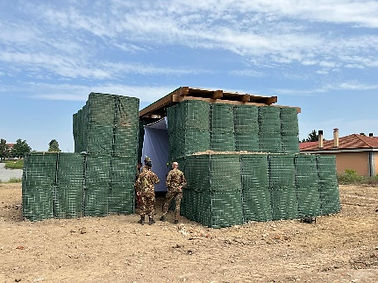
For this exhibition, he worked with the Italian Army to explode paint and dynamite on a Piedmont military base more usually dedicated to removing unexploded bombs left in the landscape since the Second World War. To make his new installation "Every Tiger Needs a Horse", 2022-2023, Omarzad created a controlled explosion, blowing up large canvases with a bomb made of dynamite and paint at a military base in Piedmont. The artist has placed the resulting large black and white paintings in the gallery. The black and white colors used by Omarzad in dynamiting the canvases recall its history, marked by constant power shifts, extremism and an ever-increasing climate of war and violence” Castello di Rivoli Museum of contemporary art

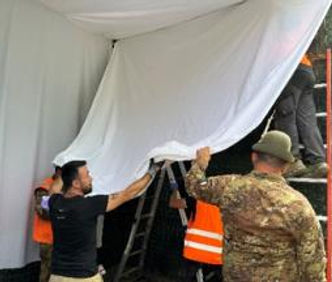
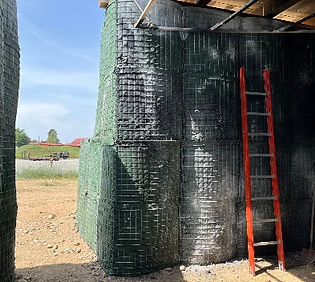
The explosion that has turned the military base into an art studio.
On May 17, 2021, three explosions occurred in one of the Italian military units. The purpose of the explosions was to create works of art by the soldiers who once served in Afghanistan in the military units of the international forces led by the United States of America.
In this project, three cubes, each containing six large canvases measuring three square meters, were detonated from within using dynamite with black and white paint on black and white canvases. The resulting black-and-white paintings created energetic and chaotic patterns on the canvases. These works depict themes of historical violence, shifts in power, and conflict, establishing a connection to Afghanistan’s turbulent past.
Omarzad’s project emphasizes the restorative and healing power of art in the face of destruction. His message, “Make Art, Not War,” is vividly reflected in this creative process, where the destructive force of dynamite is transformed into a tool for artistic reconstruction. The explosive energy captured in expressive, cosmic-like patterns on the canvases mirrors the increasing violence in Omarzad’s homeland, Afghanistan.
٬٬ Omarzad’s work comes closest to expressing a universal statement about the visual and emotional reality of war. It doesn’t merely address how military forces can turn calculated technology towards destructive and irrational ends—resulting in mutilation, death, and ruin— but rather forces us to confront the overwhelming scope of war’s potential impact.
For those who have not experienced the direct chaos and devastation brought by even brief military strikes, this exhibition is a mere, bitter sample of war’s unfathomable horrors: young men crushed in trenches; civilians hiding among the ruins of once-peaceful areas; the twisted
bodies of the dead in swelling cemeteries; the entire landscape scarred and shattered amid broken glass.٬٬Art monthly,
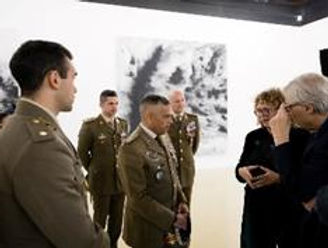

Omarzad’s project emphasizes the restorative and healing power of art in the face of destruction. His message, “Make Art, Not War,” is vividly reflected in this creative process, where the destructive
force of dynamite is transformed into a tool for artistic reconstruction. The explosive energy captured in expressive, cosmic-like patterns on the canvases mirrors the increasing violence in Omarzad’s homeland, Afghanistan.
٬٬ Omarzad’s work comes closest to expressing a universal statement about the visual and emotional reality of war. It doesn’t merely address how military forces can turn calculated technology towards destructive and irrational ends—resulting in mutilation, death, and ruin—but rather forces us to confront the overwhelming scope of war’s potential impact.

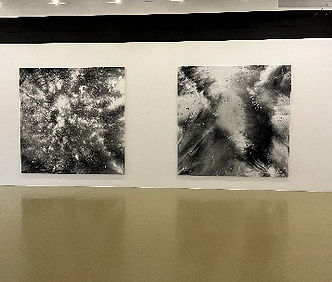

For those who have not experienced the direct chaos and devastation brought by even brief military strikes, this exhibition is a mere, bitter sample of war’s unfathomable horrors: young men crushed in trenches; civilians hiding among the ruins of once-peaceful areas; the twisted bodies of the dead in swelling cemeteries; the entire landscape scarred and shattered amid broken glass. ٬٬Art monthly,
A.2- New Scenario, three channel video performance,
Filmed At
Air-raid shelter of Piazza Risorgimento and Teatro Castello di Rivoli
“The second work created by Omarzad is the film New Scenario, 2022–23, shot by the artist inside an air-raid shelter in Turin built in 1943 after the first major bombing of the city. It proposes a reflection on the circularity of human destiny and the difficulties of freeing oneself from the logic of trauma, injury, and conflict. New Scenario shows allegorical ghost- like characters guided by a score of slow, repetitive movements in a theatrical setting consisting of props and contrasting lights that transport the viewer into a hypnotic dimension.

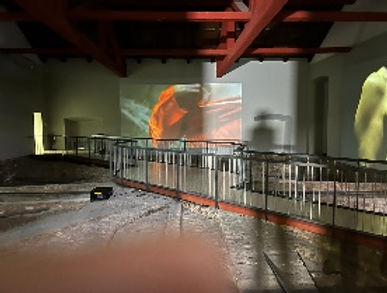
The protagonists of the allegory include, among others, a Taliban fighter, an American soldier, a businessman, as well as mythological figures wrapped in drapes, whose roles are reversed several times, like puppets of History.
His video "New Scenario", 2022-23, reflects on the circularity of human destiny and the difficulty of freeing oneself from the logic of trauma, wound and conflict. The three-channel video installation, exhibited in the darkened attic of the museum, shows symbolic, ghost-like characters guided by a score of slow movements and gestures, in a theatrical setting made up of props and contrasting lights which, together with the eerie repetitive soundtrack, create a hypnotic effect on the viewer” Museum of Costello de Rivoli.
https://www.castellodirivoli.org/mostra/esplosioni-artisti-in-guerra/
Special thanks,
To the Ministry of Foreign Affairs and the Ministry of Culture, Ministry of Defence, Esercito Italiano, General Mauro D'Ubaldi, Dr. Carolyn Cristove bakargieave Director of the Castello di Rivoli Museum, Marianna Vecellio, the Castello di Rivoli Museum of Contemporary Art of Rivoli, Turin, Museum of the Resistance of Turint, and TBA21 Thyssen-Bornemisza Art Contemporary, Francesca Thyssen, As this project is a continuation of the project "Every Tiger needs a Horse" which was done in 2007 in Oslo. In this regards I would like to special thanks to Ismail Saeed, Ghafoor Liwal, Sabourullah Siah Seng, Oslo National University of Arts and all friends who cooperated me in the first part of this project.
bottom of page